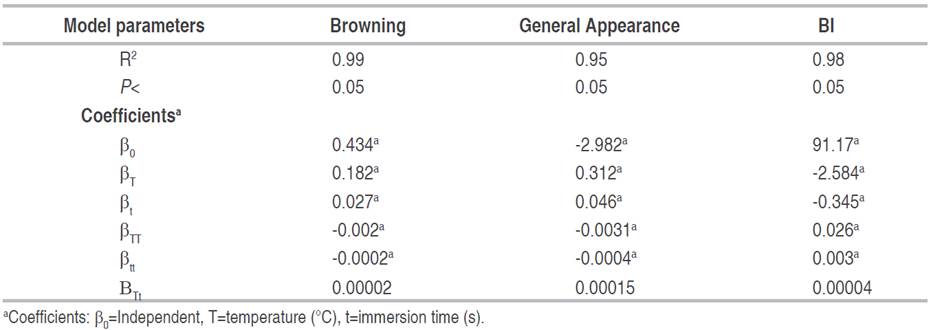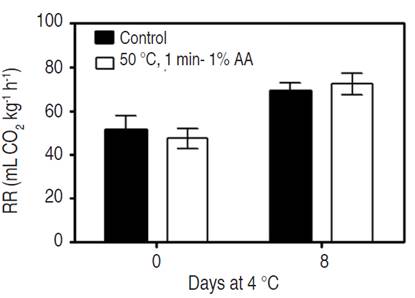The eggplant (Solanum melongena L.) is a non-climacteric vegetable belonging to the Solanaceae family containing mostly water and high phenolic content. Nowadays, this vegetable is marketed also as fresh-cut vegetable for its easy preparation and nutritional value (Barbagallo et al. 2012). However, postharvest processing, such as cutting or slicing, accelerates senescence and induces an increase in loss of commercial quality, reducing the shelf life of fresh-cut vegetables (Ansorena et al. 2014). Browning is the main cause of quality loss of fresh-cut eggplants, due to the action of enzymes such as polyphenol oxidase (PPO) and peroxidase (POD) mainly (Zhou et al. 2018), which causes the oxidation of phenolic compounds to o-quinones and subsequent brown pigments (Ghidelli et al. 2013). Therefore, reducing the PPO and POD activities is an important way to prevent browning.
Several studies have shown that low pH organic acids solutions (oxalic acid, ascorbic acid, citric acid, cysteine, kojic acid, oxaloacetic acid, erythorbic acid, 4-hexylresorcinol, calcium chloride) are used as antioxidants to inhibition/reduction of enzymatic browning, since they have a high capacity to inhibit PPO in fresh-cut products (Chiabrando and Giacalone 2012). Ascorbic acid (AA) is potentially effective in reducing enzymatic browning as it can convert soluble quinones to diphenols, and thus significantly reduce browning in treated products (Ali et al. 2021). AA was found to have been used as an anti-browning agent in mangoes (Lo'ay and Ameer 2019), lotus root slices (Ali et al. 2020a) and longan fruit (Khan et al. 2019). Oxalic acid (OA) is another organic acid that has anti-browning properties and has been applied in different horticultural crops, such as bamboo shoots (Zheng et al. 2019), longan (Khan et al. 2019), and slices of lotus root (Ali et al. 2020b). In this same way, it was found that citric acid retarded browning on litchi fruit pericarp (Ducamp-Collin et al. 2008), fresh-cut artichokes (Amodio et al. 2011), and apple slices (Chiabrando and Giacalone 2012). However, most of these chemical compounds have limited success because their inhibitory action is only temporary (Rojas-Grau et al. 2006).
On other hand, it has been recorded that heat shock treatments at 45-55 °C can be a good alternative to prevent browning since they can reduce the polymerization step of browning reactions (Aguayo et al. 2015). The hot water dipping (HWD) treatment is a technique that characterizes by being waste-free and easy to use (Aguayo et al. 2015). Thus, it was found that the use of HWD preserved the quality of fresh-cut apples (Bai et al. 2004) and onions (Siddiq et al. 2013). However, the negative effects of HWD can occur when using high temperatures and longer exposure times. Therefore, it is necessary to study the optimal processing conditions that improve conservation.
Besides, it has been reported that with the use of combined treatments an even greater extension of the shelf life can be achieved (Goyeneche et al. 2014), for example, Aguayo et al. (2015) found that the combination of heat treatments followed by immersion in calcium ascorbate helped maintain the quality of the fresh-cut apple. Similarly, the application of Ca solutions at 60 °C maintained the quality and texture of the fresh-cut melon (Silveira et al. 2011), eggplant cubes (Barbagallo et al. 2012), and the sliced carrot (50 °C, 1 min.) (Rico et al. 2007) compared to the hot water (control). However, different combinations of temperature and immersion time were not evaluated in these studies. Therefore, the objective of this paper was to evaluate different anti-browning solutions, and a combination of mild heat shock (HWD) with antioxidant dip to increase the shelf-life of fresh-cut eggplants.
MATERIALS AND METHODS
Experimental design
This work was divided into two parts: in the first evaluated the effect of dipping treatments with different antioxidants solutions upon eggplant cut into slices, while in the second the combined effect of HWD with the best antioxidant solution selected in the previous stage was study and optimized.
Response modeling
In the second part of this work the effect of two technological barriers (hot water and the antioxidant solution) were studied and modeled in function of the color and the organoleptic characteristics of fresh-cut eggplant slices through the Response Surface Methodology (RSM) using the Central Composite Design (CCD). The RSM is a group of statistical and mathematic techniques that can be used to define the relationships between independent variables and the response (Kumari and Farid 2020). The CCD selected is a full factorial with points to the center plus added star points that are used to model the curvature related to each factor and to construct a second-order response surface model (Van de Velde et al. 2016). The total number of experiments needed (N) of the CCD was determined using Equation (1) as follows:
Where k corresponds to the number of variables studied, in this case temperature and time (k=2). While 2k, 2k and N0 are the cubic, axial and center point runs, respectively. Therefore, N was calculated using Equation (1) and equals 11, corresponding to four factorial design points + four axial points + three replicates in the central point. Each variable was examined at five different levels (-α, -1, 0, 1, and +α) as follows: T=35.9, 40, 50, 60 and 64.1 °C whereas t=17.7, 30, 60, 90, and 102.3 s. The selection of the extreme levels was carried out in previous studies.
It was assumed that a mathematic function existed between the responses studied according to both variables related to HWD processing given in Equation (2).
A second order equation was used to model Equation (2) as shown in Equation (3) for each response:
Where: β0, βT, βt, βTT, βtt and βTt are the regression coefficients while T and t are the variables under study. The responses studied (Y) on each eggplant slice were general appearance, browning and browning index.
Eggplants preparation
The eggplants (Solanum melongena cv. Black Nite) were obtained from a local producer (Santiago del Estero, Argentina). After washing them with chlorinated water (150 ppm, 3 min), they were drained and sliced 1 cm thick with a sharp stainless-steel knife. They were soaked in running water for 5 min to remove phenolic compounds and enzymes from the surface; eventually, the pieces were air-dried on a clean surface. The process was carried out in a room at a controlled temperature of 15±2 °C under highly cared hygienic sanitary conditions.
Preparation of samples and application of antioxidant solutions
The cut eggplants, with optimal visual characteristics, without tissue damage and without microbial growth, were randomly divided into seven batches to apply the antioxidant solutions. For this, they were immersed for 3 min at 4 °C in different antioxidant solutions (Sigma Chemical Co) at 0.5 and 1% w v-1, of citric acid (CA), ascorbic acid (AA), cysteine (Cys) and water (control). They were then drained and packaged in a passive modified atmosphere as described below. In this stage the samples were analyzed at 0, 2, 4, 6 and 8 days of storage.
Preparation of samples and application of hot water treatments and antioxidant solution
To determine the optimal combination of HWD with the previously selected antioxidant, a Central Composite Design (CCD) was applied to define the different combinations of temperature and immersion time of the distilled water. Thus, a total of 11 tests were obtained with temperature variations between 35.9 and 64.1 °C and immersion times of 17.7 to 102.3 s. After HWD, the samples were immersed into a pH=4.5 buffer solution of 1% AA at 4 °C for 3 min and finally drained. Eggplant slices immersed in distilled water at 4 °C for 3 min were used as control.
Packaging and storage conditions
After treatments, three eggplants slices were manually packed in 17.4×13.8×4.8 cm polypropylene (PP) trays (Cellpack S.A., Santa Fe, Argentina) and heat-sealed with 35 µm thick bi-oriented PP film featuring an O2-transmission rate of 5,000 mL m-2 24 h-1 atm-1 and 18,000 mL CO2 m-2 24 h-1 atm-1 and a water vapor transmission rate of 110 g m-2 24 h-1 atm-1 (data provided by INTI, Argentina) and then were stored at 4 °C.
Each fresh-cut eggplant package with three slices was considered as one experimental unit. Samples were immediately evaluated in the case of the determinations of sensory evaluation, color measurement and respiration rate, or immediately frozen at −80 °C (Ultrafrezzer Righi, Argentina) and stored until chemical analysis were performed. On each evaluation day, at least three packages per treatment were collected for analysis and the results were expressed as the mean values with SE.
Sensory evaluation
During storage, 10 trained judges evaluated visually the eggplant slices. The general appearance (such as shape, color, and texture) and browning were scored on a 1-9 scale, being one for poor and nine for excellent. Scores below five were considered the cut-off point for quality attributes (Ghidelli et al. 2013).
Color measurement
The surface color values of eggplants samples using a CR-300 Minolta Chroma Meter (Osaka, Japan) and the CIELAB color parameters, namely, L* (lightness), a* (red-green chromaticity), and b* (yellow-blue chromaticity) were determined. For that, a total of eight readings were taken from both sides of each eggplant slices from each experimental unit. The Browning Index (BI) was calculated as follows Equation (4) (Bal et al. 2011):
Where:
Respiration rate
The respiration rate (RR) of the control and optimized treatment samples was measured on days 0 and 8 of storage using a closed system. On each sampling day, three slices of eggplant (approximately 120 g) were placed within 1,000 mL glass jars and stored at 4 °C. The increase in CO2 as monitored 0.5 h after closing the jars using a gas chromatograph (SRI 8610C, EUA), equipped with a thermal conductivity detector (150 °C), oven (80 °C), injector (150 °C), and Poropack-Q 80/100 column. He (20 mL min-1) was used as the carrier gas. All measurements were conducted in triplicate and the CO2 production was expressed in mL CO2 kg-1 h-1.
Phenolic compounds and antioxidant capacity
The phenolic compounds were determined as described by Concellón et al. (2004) with slight modifications. For this, a methanolic extract was prepared by crushing 1 g of frozen tissue with 10 mL of methanol, which was subsequently centrifuged and the methanolic supernatant extracted. Then, 350 µL of the methanolic extract was mixed with 50 µL of Foling-Ciocalteu and 500 µL of distilled water, allowing the mixture to react for 30 min and measuring the absorbance at 760 nm, using commercial chlorogenic acid as standard. The results were expressed in g kg-1 of fresh tissue.
To determine the electron donating capacity of the samples, the radical DPPH• was used, following the procedure described by Brand-Williams et al. (1995). Thus, 50 µL of the methanolic extract prepared as described above, was mixed with 500 µL of DPPH• in a methanolic solution. The absorbance was determined at 515 nm using Trolox as a standard, and the results were expressed in g kg-1 of fresh tissue. All determinations were made in triplicate using a JASCO V-630 spectrophotometer.
Determination of polyphenol oxidase (PPO) and peroxidase (POD) activity
The PPO activity was determined according to Concellón et al. (2004), grinding 5 g of frozen sample with 20 mL of phosphate buffer (0.05 M, pH=6.5, 4 °C), 10 g L-1 of polyvinylpolypyrrolidone (PVPP); and 0.1% v v-1 Triton X-100. The mixture was centrifuged at 15,000xg for 20 min at 4 °C and the supernatants were collected using as enzyme extracts. The reaction mixture was prepared from 50 µL of the extract with 1 mL of pyrocatechol (20 mM) in phosphate buffer (0.10 M, pH=6.5) and incubating at 25 °C. The absorbance was then measured spectrophotometrically at 410 nm.
The POD activity was analyzed according to the method described by Li et al. (2014) with slight modifications, mixing 4 g of sample with 25 mL of phosphate buffer (0.05 M, pH=6.5) for extraction. The homogenate was centrifuged at 15,000xg for 20 min at 4 °C and the supernatant (1 mL) was mixed with phosphate buffer (0.05 M, pH=6.5), 300 µL of 0.5% H2O2, and 0.1 mL of guaiacol 2%. The reaction mixture was incubated at 25 °C and the enzymatic activity was determined spectrophotometrically at 430 nm.
One unit of enzyme activity (UEA) was defined as the amount of extract that produces an absorbance change of 0.001 units per min under assay conditions. For both enzymes, the results were expressed as UEA per mg protein. Three extracts were prepared for each treatment and storage time.
Protein determination
The protein content was determined by Bradford's method (1976) in the different extracts using bovine serum albumin as the standard protein.
Statistical analysis
All experiments and analysis were carried out in triplicate. The statistical analysis was performed using the Infostat software in its 2011 release (National University of Cordoba, Argentina). The means specific differences were determined by the least significant difference (LSD) method applied following the analysis of variance (ANOVA); the significance of differences was defined at P<0.05.
RESULTS AND DISCUSSION
Sensory evaluation
Figure 1 shows the general appearance and browning of fresh-cut eggplant slices treated with different antioxidants during storage at 4 °C. All the sensory parameters decreased as time of storage due to the natural oxidative processes which are particularly high in fresh-cut products (Amodio et al. 2011).
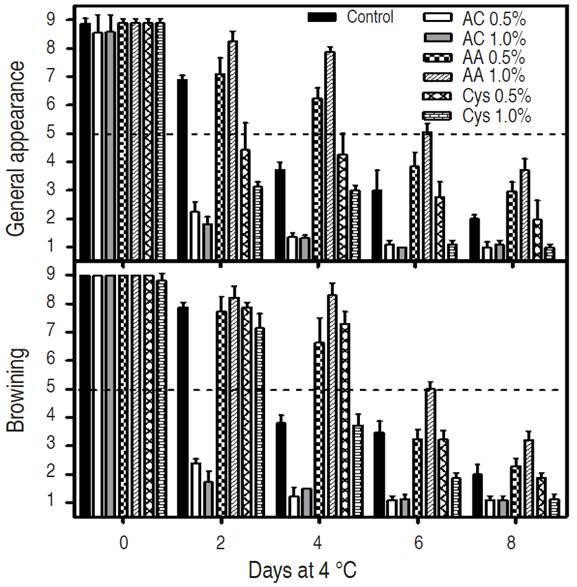
Figure 1 Effect of antioxidant type and concentrations on general appearance and browning of fresh-cut eggplants stored for 8 days at 4 °C. Data shown are mean ± standard error. LSD (P<0.05). General appearance=0.44. LSD (P<0.05) Browing=0.50.
Control samples reached the cut-off point before 4 days of storage, due to excessive browning, affecting the general appearance. Eggplant slices treated with AA at both concentrations presented very good scores on the general appearance and browning on day 4 of storage. However, on day 6, only the concentration of 1% allowed to preserve acceptable characteristics for commercialization, with values close to 5 (limit of acceptability). Therefore, the antioxidant effect of AA solutions was dependent on the concentration used. This agrees with what was reported by Ghidelli et al. (2014), who reported that the use of AA in persimmon at 1.12% and 2.25% allowed reaching a marketability limit of up to 7 and 5 days, respectively. Similarly, the same trend was observed in eggplant cv. Telma cut into cubes, since the 0.35 and 0.88% AA concentrations showed better results in color maintenance than the control (untreated), while 1.75% AA increased the browning of the fruits (Ghidelli et al. 2013).
The samples treated with 0.5 and 1% Cys presented inappropriate visual characteristics from day 2, with a decrease in their general appearance and a significantly higher browning than those treated with 1% AA. This effect is attributed to the action of Cys, which affected both the pulp, increasing browning, and the skin, since it modified the characteristic purple color of the fruit towards a reddish-pink, spreading towards part of the pulp that is in contact with the skin. These characteristics were similar to those recorded in pear slices treated with a 0.5% Cys solution as it caused an undesirable appearance due to the formation of pinkish-red pigments (Gorny et al. 2002; Siddiqui et al. 2020). Furthermore, this antioxidant in both concentrations was excluded as they also produced an unpleasant odor inside the package (data not shown).
On the other hand, CA at both concentrations (0.5 and 1%) was the antioxidant that caused the highest degree of browning and decrease in the general appearance in eggplants slices during storage resulting in a commercial shelf-life shorter than 2 days. However, in other products, CA treatment may be adequate to prevent browning such as persimmon, in which the application of a 0.21% CA solution allowed to preserve its quality for 7 days at 5 °C (Ghidelli et al. 2013). According to these sensory quality attributes, the AA 1% dipping treatment was considered as the best antioxidant solution since maintained the highest visual quality and least browning of fresh-cut eggplants up to 6 days of storage at 4 °C.
Color parameters
Different authors have used the values of lightness (L*) and browning index (BI) for describing browning in vegetables, the latter being a good indicator of the darkening of the samples due to increased pigments concentrations (Arias et al. 2008). The surface color parameters L* and BI for the eggplant slices treated with different antioxidant solutions were evaluated during storage (Figure 2). Browning was accompanied by a decrease in L* and an increase in BI.
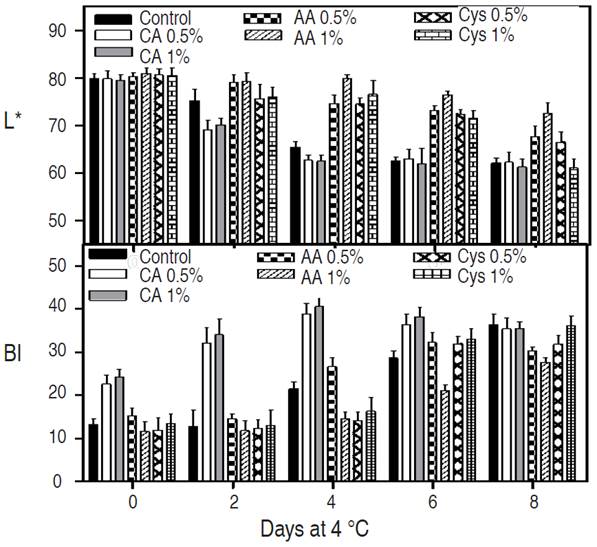
Figure 2 Effect of antioxidant type and concentrations on colorimetric parameters of lightness (L*) and browning index (BI) of fresh-cut eggplant stored for 8 days at 4 °C. Values are mean ± SD of three experiments and 24 readings at each time, n=72.
The control showed a decrease and a significant increase in L* and BI, respectively, during the first 6 days, remaining unchanged afterwards, the eggplants presenting a very high superficial darkening at the end of the storage. The treatment with 1% AA allowed to control enzymatic browning during first 4 days at 4 °C, since that maintained stable values of L* and BI parameters. The 0.5% AA treatment was not adequate to reduce browning, as it presented values of L* and BI significantly lower and higher respectively, after 2 days with respect to the concentration of 1%. Using AA as inhibitor of enzymatic browning in vegetables is widely used since reduces the change of quinones into non-colored phenolic compounds (Ghidelli et al. 2014; Chiabrando and Giacalone 2012). In this regard, very good results on browning inhibition and shelf-life prolongation were reported in litchi fruit (Ali et al. 2021), diced eggplants (Ghidelli et al. 2014) and fresh-cut apples (Chiabrando and Giacalone 2012) treated with AA compared to untreated samples.
Cys was also effective in controlling browning in the eggplant slices, showing practically stable BI values during the 4 days of storage. However, the samples presented lower L* and higher BI values than those immersed in 1% AA from 6 days of storage. This may be due to discoloration in the skin fresh-cut eggplants that appeared with an intense reddish-pink color which spread to the pulp. These results do not agree with what was reported by Ghidelli et al. (2014) since 1% Cys was considered the most effective antioxidant to reduce browning of cubed eggplant. However, in that study an organoleptic evaluation was not carried out and no changes in odor or reddish coloration were reported due to the absence of skin in the samples. On the other hand, CA at concentrations of 0.5 and 1% was the antioxidant that caused the highest degree of browning in fresh-cut eggplants even higher than the control samples, presenting the lowest L* and the highest BI values during 4 and 6 days at 4 °C respectively, and remained stable until the end of the storage. This could be due to the fact that in certain cases the CA in the presence of ascorbic acid typical of the vegetable, would participate in the formation of brown pigments, either acting as a catalyst for the oxidation of ascorbic acid, a catalyst in the accumulation of brown pigments, influence in the process of decomposition of ascorbic acid to a variety of carbonyls, or else behave similarly to amino acids and react with some products of ascorbic acid oxidation (Clegg 1966; Zeki 2016). These results obtained agree with Ghidelli et al. (2014) who worked with fresh-cut eggplants (cv. Telma) and found that the CA solutions increased browning and reduced L* values with respect the control.
These results of color parameters were in agreement with the sensory attributes of general appearance and browning. Therefore, the data collected demonstrated that the 1% AA solution was effective in reducing browning in fresh-cut eggplants for 6 days of storage at 4 °C.
Optimization of HWD treatment combined with antioxidant solution
In accordance with the previous results, the 1% AA solution was effective in controlling browning in fresh-cut eggplant up to 6 days of storage at 4 °C. From this, a second experiment to evaluate the use of combined HWD treatments followed by immersion in 1% AA as a double barrier to reduce the enzymatic browning of fresh-cut eggplant and preserve for a longer time. To optimize the process, the RSM was used and through the application of a CCD, different combinations of temperatures and immersion times of the HWD were established, evaluating the general appearance, browning and BI at day 8 of storage, whose results are presented in Table 1. On the basis of these results, three-dimensional response surface plots were generated to demonstrate the effects of exposure times and temperatures on the general appearance, browning, and BI of fresh-cut eggplants.
Sensory evaluation
Figure 3A shows the effects of HWD immersion times and temperatures followed by 1% AA immersion on the overall appearance of fresh-cut eggplants at 8 days storage at 4 °C. Both temperatures and times significantly (P<0.05) affected this attribute. As can be seen, treatments with temperatures above 60 °C and below 40 °C caused a significant decrease in the overall appearance scores of the treated samples. Similarly, immersion times greater than 80 s and less than 40 s also produced significant reductions in scores for this attribute. This may be because prolonged temperatures and times could damage the tissue and thereby affect the visual quality of the eggplant during storage. For example, Aguayo et al. (2015) discovered that high temperatures induce damage to the surface of fresh-cut apples by decreasing the L* parameter and color (hue angle and chroma). On the contrary, low temperatures and times did not generate a positive effect on the conservation of the product, which may be associated with the fact that temperatures below 40 °C do not inhibit the PPO enzyme in this product, according to what was reported by Concellón et al. (2004). When analyzing the browning, it is concluded that its behavior was similar to that of the general appearance (Figure 3B), since temperatures below 40 °C and above 60 °C and immersion times below 40 s and above 80 s caused a significant decrease in the scores of this parameter.
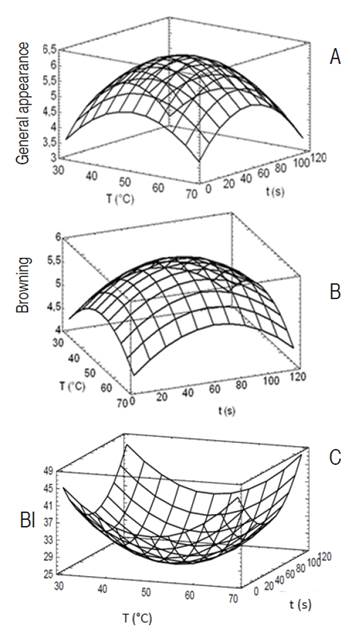
Figure 3 Effects of hot water dipping treatment temperatures (°C) and immersion times (s) on the A. general appearance. B. browning and C. BI of fresh-cut eggplants at 8 days of storage at 4 °C.
Based on this experiment, heat treatment with an intermediate temperature and time ratio of 50 °C and 60 s respectively was selected as the best combination to maintain visual quality and reduce the browning of fresh-cut eggplants for 8 days. This agrees with what was reported by Constant et al. (2021), who reported that heat treatment at 65 °C for 30 min considerably reduced browning by inhibiting PPO activity, as well as the use of the antioxidant ascorbic acid, reducing this enzyme by approximately 80% in whole eggplants. In this way, Loaiza-Velarde et al. (2003) also discovered that applying heat shock at 50 °C for 90 s delayed the browning potential increase in fresh-cut celery petioles by three weeks.
The results show that the combination of HWD (50 °C, 60 s) followed by immersion in 1% AA solutions, delayed the browning of the tissue and maintained the visual quality of the fresh cut eggplants for up to 8 days at 4 °C, while than individual 1% AA treatment for only 6 days.
Color parameters
Thermal treatments had a relevant impact on the BI of fresh-cut eggplants (Figure 3C). As can be seen, treatments with temperatures above 60 °C and below 40 °C caused an increased significant BI values. In the same way, immersion times below 40 s and above 80 s caused the same result. Therefore, a thermal treatment with an intermediate ratio temperature and time of 50 °C and 60 s to maintain the color of fresh-cut eggplants during storage was select. In addition, these results were consistent with those obtained in the sensory evaluations performed by the trained panel.
In that same sense Goyeneche et al. (2014) reported similar results in sliced radish treated by dipping with hot water at 50 °C for 1 min followed of 0.3% CA. On the other hand, Aguayo et al. (2015) reported that treatments with hot water (48 °C, 2 min) followed by 6% of Ca ascorbate showed a greater reduction of browning than when treated with hot water without Ca ascorbate in fresh-cut apples. Based on the analysis of these parameters, the combination of HWD (50 °C, 60 s) followed by immersion in solutions of 1% AA, were determined as the optimal conditions for maintaining the color of fresh-cut eggplants during 8 days of storage at 4 °C.
Respiration rate
Figure 4 shows the respiration rate (RR) of fresh-cut eggplants with the optimized antioxidant treatment and control (untreated) during storage at 4 °C. This parameter tended to increase during storage no observing significant differences observed among them, indicating that the applied treatment did not induce additional tissue damage and that the plant tissue is still alive. However, different authors reported that the application of thermal treatments reduced the RR of various fruits and vegetables (Ansorena et al. 2014).
Phenolic compounds and antioxidant capacity
Phenolic compounds (PhC) are a group of secondary metabolites belonging to the plant kingdom, of great functional value due to their antioxidant action (Goyeneche et al. 2015). As a result of the application of optimized treatment, PhC values were initially significantly higher than those of the control by approximately 20% (Table 2).
Table 2 Phenolic compounds (PhC), antioxidant capacity (DPPH•), and enzyme activity PPO and POD for the control and treated samples during cold storage.
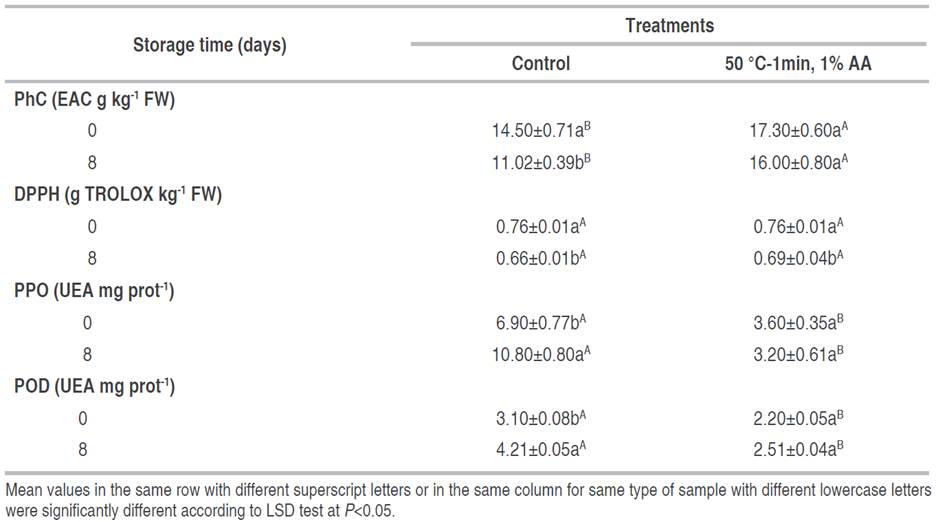
At the end of storage, the values decreased in the control, while in the treated samples remained practically unchanged. Likewise, in studies carried out Barbagallo et al. (2012) with "Birgah" eggplants cut into cubes and treated with a 60 °C solution of citrate and calcium ascorbate, an increase in the PhC content was also reported.
Regarding antioxidant capacity measured by DPPH• (Table 2) no significant differences were observed (P>0.05) between the treatment and the control during the time evaluated. This probably is associated with its high antioxidant capacity because the high content of phenols in eggplants, and also that possibly other substances of a different nature than polyphenols contribute to the antioxidant capacity, such as anthocyanins, beta-carotenes, etc. However, these results differ from what was observed in radish slices treated with hot water (50 °C, 1.5 min) followed by immersion in a 2% AA solution, in which it was determined that the antioxidant capacity was always significantly higher than the untreated samples (Goyeneche et al. 2015).
Polyphenol oxidase and peroxidase activity
During the minimal processing of fruits and vegetables, a series of deterioration reactions are generated that involve enzymes that act on the nutrients and deteriorate their quality. Among these enzymes, we can mention the PPO and POD. PPO acts mainly in the oxidative processes of phenolic compounds, while POD participates in various deterioration reactions (Siddiqui et al. 2020). Therefore, researchers have reported that increases in POD activity may be associated with increased browning (Ciou et al. 2011).
Table 2 shows the effect of the optimized antioxidant treatment on the PPO enzyme activity of the fresh-cut eggplants. Initially, PPO activity was significantly reduced by 50% in treated samples compared to untreated samples (control). Subsequently, it increased significantly for the control, however the PPO activity of the treated samples remained without significant variations. Regarding the POD activity, the Table 2 shows that it had a similar trend to that registered for PPO. According to ANOVA, the treated samples showed a significant reduction (P<0.05) in their activity compared to the control, which was maintained for 8 days, relating these values to that of PhC since they registered higher levels than the control. These results are in agreement with Goyeneche et al. (2015), who reported that immersion in hot water at 60 °C for 1.5 min followed by immersion on 2% AA were effective to reducing and maintained the PPO activity during 7 days of storage in fresh-cut radish. Similarly, the beneficial effect of heat treatment on browning was related to a reduction in PPO activity in apple cut into slices (Bai et al. 2004). Furthermore, AA has good potential to reduce the incidence of browning by suppressing PPO and POD activities (Ali et al. 2021).
Therefore, the combined treatment optimized through this work was effective in reducing the browning of the fresh cut eggplant slices, since it reduced the activity of PPO and POD allowing to maintain visual quality, and thus extending the shelf life up to 8 days at 4 °C.
CONCLUSIONS
Dipping treatments in a solution containing 1% AA was considered as the best antioxidant solution, since can effectively reduce browning of fresh-cut eggplants up to 6 days of storage at 4 °C. However, the combined application of HWD at 50 °C for 60 s followed by dipping in solution of 1% AA, allowed control for longer time the browning of fresh-cut eggplants without significantly affecting the RR, extending their shelf life up 8 days at 4 °C. The positive effect of HWD+1% AA on browning control and color retention of eggplant slices was related to low levels of enzyme activity of PPO and POD. Furthermore, the phenols content was significantly increased by applying this optimized treatment, but without effect on its antioxidant capacity. These results suggest that hot water dipping treatment (50 °C, 60 s) combined with 1% AA can be considered a good alternative to maintain the overall appearance and browning control of fresh-cut eggplants.



















